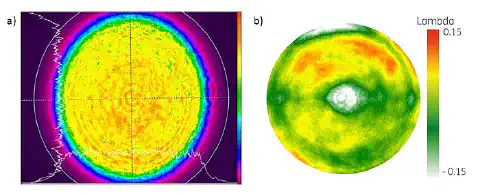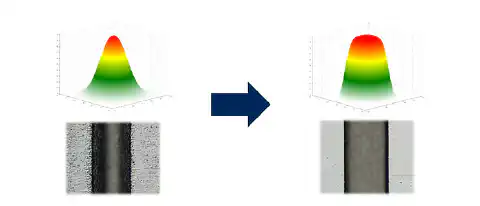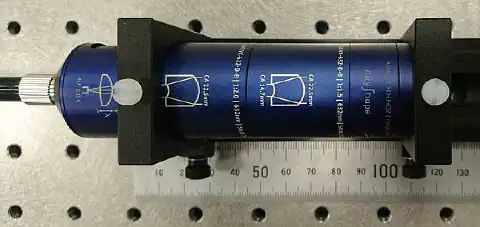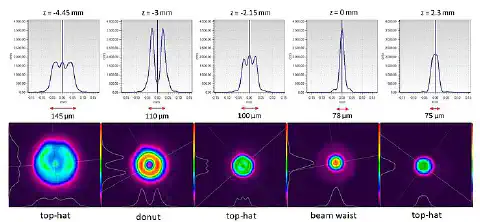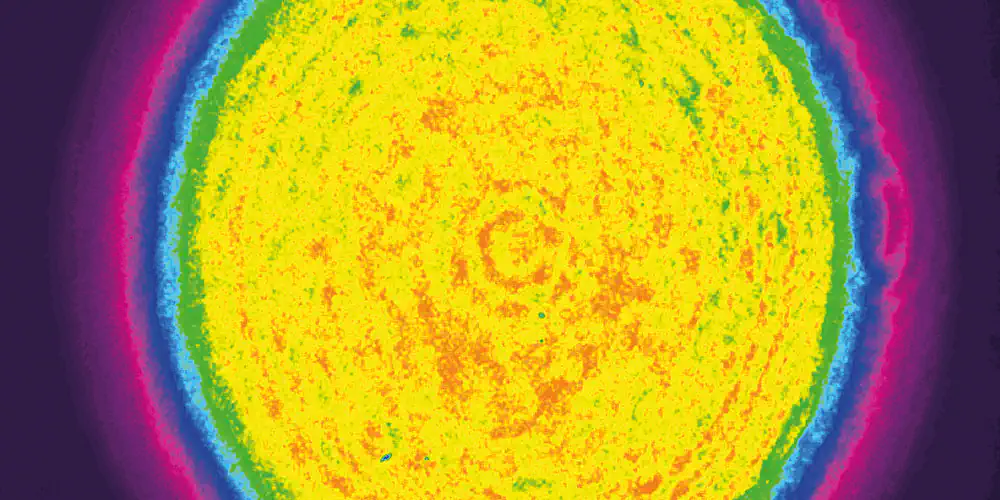
Top-Hat beam shaping with aspheres
Compact beam shapers for transforming Gaussian laser beams into Top Hat beams
Content
Gaussian beam profiles are used in most laser applications. However, there are fields of application in which a homogeneous intensity distribution (so-called Top-Hat distribution) is required within the entire beam diameter, for example in order to generate optimum illumination. Especially in the fields of metrology, microscopy or material processing, homogeneous intensity distributions play a significant role. The following article shows how aspheres can be used for beam shaping and the generation of Top-Hat profiles, respectively.
Refractive beam shaping with a|TopShape to produce homogeneous intensity distributions
A collimated Top-Hat distribution can be generated out of a collimated Gaussian beam by beam shaping using aspheres. The idea behind it is not new: an aspherical lens is used, which redistributes the rays of the incoming beam in such a way, that a homogeneous intensity distribution is generated at a certain distance. The beam is collimated again with a second asphere. However, a disadvantage of existing beam shaping systems is the large distance between the aspheres and the resulting overall length. This distance is used to compensate production-related imperfections of the lens surface.
Figure 1) Schematic view of the beam shaping system a|TopShape in combination with the fiber collimator a|AspheriColl and a|BeamExpander for flexible adaptation of input and output beam diameters.
With the a|TopShape asphericon offers a very compact Gaussian to Top-Hat beam shaper, which is only half the size of previous systems. The reduced overall length is possible amongst others due to the high accuracy of the aspherical surfaces. The result is a Top-Hat beam profile, which can be flexibly adapted to a wide variety of tasks with the help of a|BeamExpander and a|AspheriColl. An exemplary setup with fiber coupling and the scaling of input and output beams is shown in Figure 1.
Application of a|TopShape in the laboratory
Figure 2 shows an experimental setup of a|TopShape in combination with two a|BeamExpander and one a|AspheriColl for fiber coupling. The complete assembly requires only a space of approx. 200 mm. The resulting intensity distribution was measured with a beam profile camera (Ophir SP928) at a wavelength of 635 nm at a working distance of 100 mm (see Figure 3). The intensity distribution for this setup has an ISO plateau uniformity of 0.33 and an ISO edge steepness of 0.4. It should be noted, that the recorded beam profile was created after passing through 12 surfaces, 6 of them are aspherical.
Figure 2) Experimental setup consisting of: a|AspheriColl, two a|BeamExpander and a|TopShape.
Furthermore, the resulting wavefront was detected by a high-precision sensor from Phasic’s SID4-HR-307c (300 x 400 pts). Due to the limited sensor size, another a|BeamExpander was added to the beam shaping setup shown in Figure 2 and the beam diameter was reduced to the required size. After passing through 14 surfaces, 7 of them are aspheric, the resulting wavefront has an RMS wavefront error of 0.05λ, which corresponds to a Strehl ratio of 0.9 (λ = 632).
Figure 3a) Measured beam profile and 3b) measured wavefront of the setup shown in Figure 2 using a coherent laser source.
During the experiment, a stable Top-Hat intensity distribution of at least 300 mm along the optical axis was obtained. The a|TopShape is often used in the fields of illumination and metrology, but also in fluorescence microscopy.
Practical application of the a|TopShape
Quantitative analyses of laser-based fluorescence microscopy are very demanding - especially when they are based on Gaussian beam profiles and the slides are unevenly illuminated. Due to inhomogeneous illumination, the molecules are irregularly activated (the greater the distance to the center of the illumination, the lower the fluorescence) and stitched images lose their informative value due to darkened borders. Homogeneous, non-Gaussian beam profiles can help here. A transformation of the Gaussian beams in the microscope set-up, using the a|TopShape, into homogeneous, flat Top-Hat profiles ensures an even illumination of the slide and uniform activation of the molecules. Stitched images are easier to read and more meaningful. ELearn more about the use of the a|TopShape in imaging fluorescence microscopy in a paper by I. Khaw et. al. of CREOL.
Refractive beam shaping with a|AiryShape for generating focused Top-Hat distributions
Laser material processing is widely used (not only in optics), for example for drilling or cutting metal. If a laser with a Gaussian beam profile is used for this purpose, the intensity decrease at the edge of the beam has an effect on the quality of the cutting edge (see Figure 4). High-quality results require further cuts, which in turn effects on the efficiency of the process.
Figure 5) Influences of the beam profile on the results of the material processing; according to: Kanzler, K., “How much energy are you throwing away?” Photonics Spectra 7 (40), (2006).
A homogeneous intensity distribution at the focal plane can solve the problem, since it allows uniform heat input into the material, which results in smooth cutting edges.
By using the a|AiryShape top hat beam shaper in combination with a focusing lens, different beam profiles (Top-Hat or Donut distribution) can be created in different sizes depending on the requirements. The working principle of the a|AiryShape is based on diffraction theory and Fourier transformation. The Gaussian intensity distribution of a collimated beam is first converted into a Bessel-sinc distribution (Airy distribution) by means of a phase plate. Subsequently, due to the Fourier transformation, a Top-Hat distribution occurs at the focal plane of the lens.
Figure 5 shows a setup of a|AirySape in combination with a|BeamExpander for beam adaptation and a|AspheriColl for fiber coupling as well as a focusing lens. The diameter of the Top-Hat profile in the focus can be scaled by the choice of the focal length of the focusing lens.
Figure 6) Schematic view of the beam shaping system a|AiryShape in combination with a|BeamExpander, a|AspheriColl, and a focusing lens.
Another field of application of the focused Top-Hat is additive material processing, the so-called 3D printing. The Top-Hat focus is used here to fill larger areas within fine contours that have previously been sintered by laser-sintering.
Application of a|AiryShape in the laboratory
Figure 7) Experimental setup consisting of the following components: a|AspheriColl, two a|BeamExpander, a|AiryShape and a focusing lens (f = 200 mm).
An experimental setup consisting of a|AspheriColl for fiber coupling and a|BeamExpander for scaling the beam as well as an a|AiryShape element and a focusing lens (f=200 mm) for characterizing the described beam shaping system is shown in figure 6. The total length of the system is approx. 150 mm. The a|AiryShape has the advantage, that several intensity distributions can be generated in different working planes with one and the same setup. In order to make the beam profiles visible with a beam profile camera (Ophir SP928), the image plane has only be shifted along the optical axis. The five characteristic beam profiles (three different Top-Hat distributions, the beam waist and a Donut distribution) were also detected with the beam profile camera and are shown in figure 7. In addition, sizes and distances are indicated.
Figure 8) Beam profile measurement with a|AiryShape, including 2D- and cross-sectional plots of the characteristic beam profiles (λ=635 nm)
Flexible and robust beam shaping with aspheres
The two refractive beam shapers presented enable flexible and high-quality beam shaping. A considerable advantage of both components is the modular design. Thus, both systems can be used with a collimated beam and with a fiber-coupled source as well. In addition, the input and output beam can be scaled, so, both systems can be easily integrated into existing setups. Metric fine threads on all components also ensure smooth handling. The high-precision assembly of all optical elements in their mounts enables perfect alignment within the beam path.


